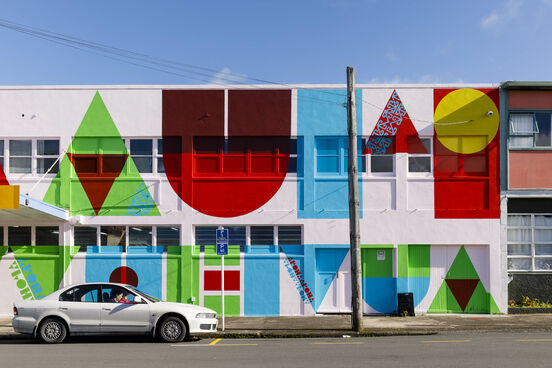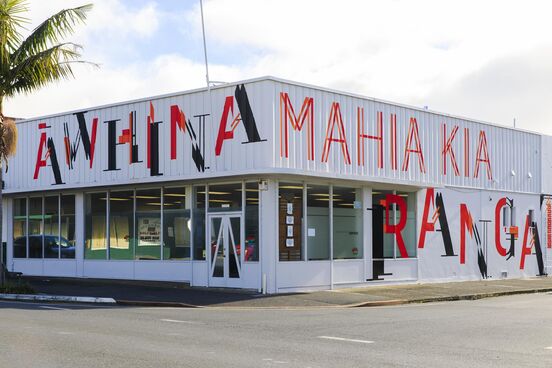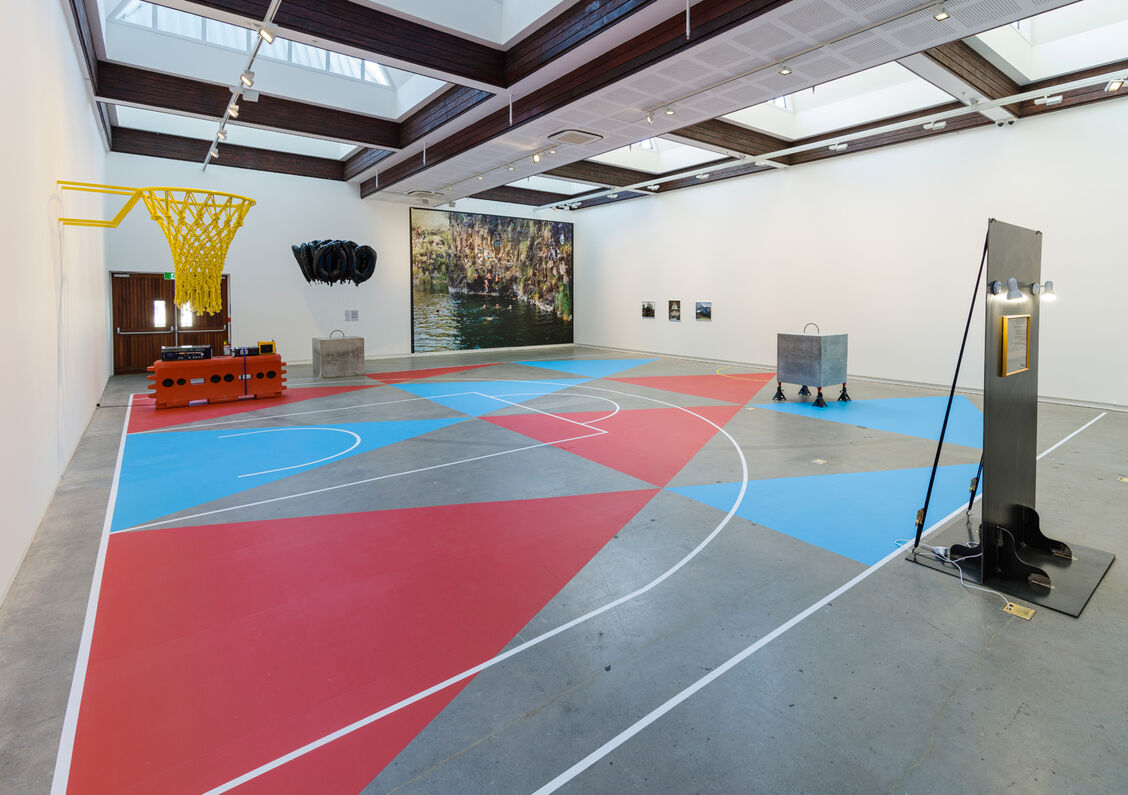Interview with ĀKAU
ĀKAU: ĀKAU strives to empower taitamariki around Aotearoa to feel more connected and creative so that they can navigate the future with confidence. We help taitamariki recognise and harness the creativity of their tūpuna by involving them in tangible projects that have real impact for taitamariki, their whānau and their community.
Objectspace: Can you talk about the basketball court design that is included in the gallery? How did this come about?
Ā: This project was driven by the local Kaikohe community and ĀKAU was engaged to complete the design. We worked with a rōpū of community members interested in seeing the basketball court be a colourful community space, whānau friendly and unique to Kaikohe. The design of the court was inspired by the mahi of a rōpū of kōtiri from Kaikohe Intermediate.
The Niho Taniwha design is about moving forward together in formation with the leader being flanked by their peers. It talks of mahitahi and leadership. The colours reaffirm these ideas – kikorangi represents wai as in waiora and life; karaka as in ahi kā, fire and energy. The colours are bright and bold like our taitamariki.
OS: Can you tell us a little about your ongoing kaupapa in Kaikohe, Te Reo Māori on the Streets?
Ā: Te Reo Māori on the Streets is a kaupapa that came from the desire of young people in Kaikohe to ‘see te reo Māori everywhere!’ and for their town to be bright and colourful. Working through a creative process, tamariki considered whakataukī from their own perspectives. These studies resulted in a series of kupu that formed the basis of their initial designs. Exploring abstraction, composition and colour they created concepts which were then developed by professional designers and artists into large-scale murals, painted on the streets of Kaikohe. The physical impact of this kaupapa in Kaikohe has been HUGE. Hearing the positive feedback from the community and their whānau makes tamariki proud of what they have achieved and has built up their confidence.
We are always looking for opportunities to showcase the importance of reo Māori, its revitalisation, and the creativity of tamariki. Through this exhibition we are making connections with mana whenua, local artists and tamariki of the area so we can look at bringing the same energy to a project in Ōtautahi in the near future.
OS: Creating real-world outcomes through collaborative design with tamariki has become integral to your mahi. You have championed tamariki being part of the design process from the beginning, rather than after the initial decisions have been made. Why has tamariki involvement become so important for ĀKAU’s mahi?
Ā: Tamariki involvement is essential for ĀKAU. They bring amazing creative ideas to any kaupapa. They have no restrictions and bring no adult politics. Our creativity and thinking can become more conditioned as we get older – tamariki don’t have these boundaries.
Through this mahi they are creating the foundations for their own future. The spaces they create become an unconscious anchor to their dynamic future. For example, through being involved in Te Reo Māori on the Streets, tamariki gained expressive skills. They learnt to communicate their whakaaro, they formed relationships, and, most importantly, they learnt more about who they are and where they come from.
When we have tamariki create in a public space, they are engaged 100% with the final outcome. They have a sense of ownership, an understanding of kaitiakitanga over the space. We see their spaces being protected by them – signs of tagging, damage and negative activity is reduced. It’s about growing their understanding of their worth and value, that they are important enough to design and build their communities.
OS: The exhibition captures fragments of the built environment and land use that often go unseen – perhaps because they are so much a part of our everyday experiences. What would you like the viewer to be seeing in your work?
Ā: We use a creative process to help conceptualise ideas, needs and aspirations with whānau for community projects. Through this process we believe we achieve great design outcomes. That is, design that is contextual and an authentic response to local culture and surroundings. We hope that the audience sees this vigorous process and understands that each aspect of the design has significance, that it’s a process of connection. There is always collaboration and multiple viewpoints involved – tamariki, whānau, community, professionals. It’s never an expression of one.
—
This text is republished from Toro Whakaara: Responses to our built environment, a publication produced by Objectspace to accompany an exhibition of the same name. The publication is edited by Tessa Forde, and copy-edited by Anna Hodge.

ĀKAU, Kaikohe basketball court, 2019. Photograph by Aerial Vision.

(above & below) ĀKAU, Te Reo Māori on the Streets, Ongoing. Photograph by Jonny Davis.


Installation view of Toro Whakaara: Responses to our built environment presented by Architectus at CoCA Toi Moroki. Photograph by John Collie.